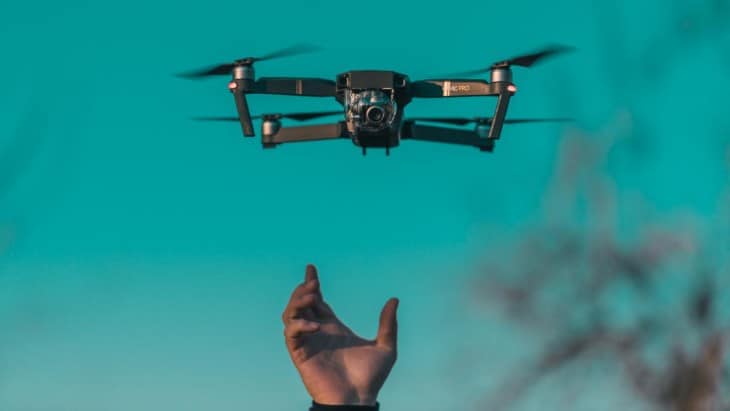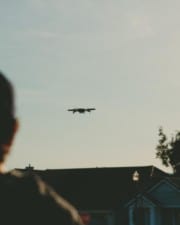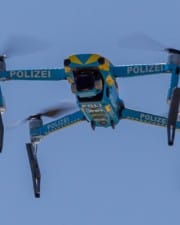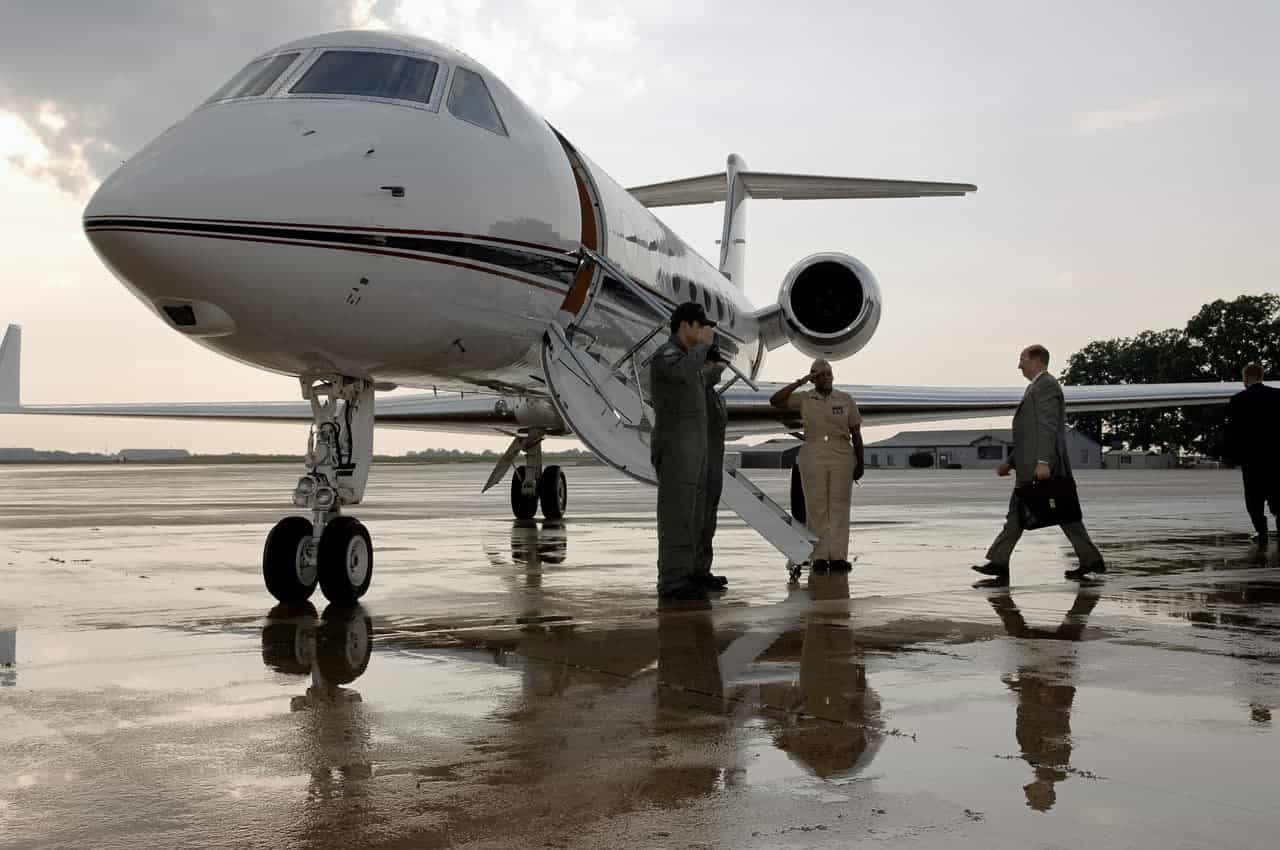Many people find drones to be a nuisance. There are close to 1.3 million registered drones in the US and over 116,000 registered drone operators. Shooting a drone out of the sky may be tempting but it is also illegal according to Federal and state laws. So, how can you legally take down a drone?
TLDR – Destroying, damaging, or interfering with a drone is a federal crime, as drones are classified as aircraft and bound to the same laws. However, there are legal ways to stop drones from flying over private property, including filing a legal complaint against the operator.
Can I shoot down a drone?
It is illegal to shoot a drone out of the sky, even when the drone is flying over private property. There are several reasons why shooting a drone is illegal:
- Shooting an aircraft is a federal crime
- Firing a weapon may be considered criminal mischief
- State and local laws may include additional restrictions for firing weapons
- Homeowners do not “own” the airspace above their properties
- Claiming self-defense is not a viable option
- The drone operator may sue the shooter in civil court
Under Title 18 US Code 32, the destruction of aircraft is a federal crime. The Federal Aviation Administration (FAA) classifies all types of drones as “aircraft.” Even recreational flyers are required to follow FAA regulations for flying in uncontrolled airspace.
Along with being charged with a federal crime, an individual who shoots down a drone may be charged with one or more state or local crimes. For example, many jurisdictions consider firing a weapon in public a form of criminal mischief. In some areas, the individual may also be charged with endangering the public or property crimes.
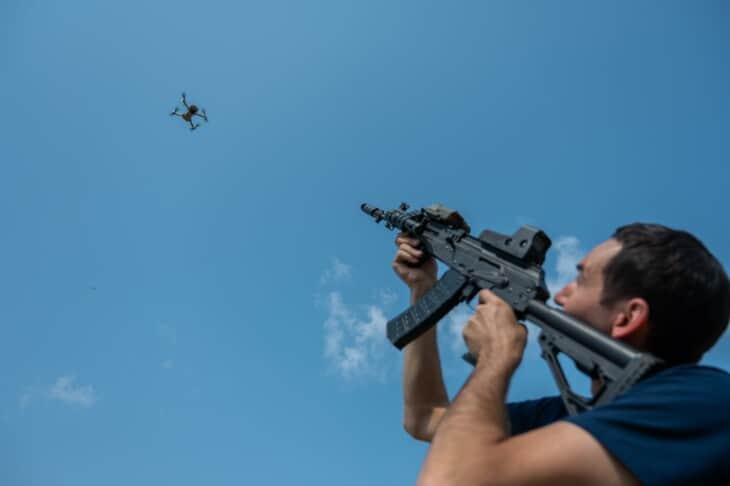
Homeowners may attempt to claim self-defense after shooting down a drone. However, homeowners do not own the airspace above their properties. The FAA considers all airspace to be under its jurisdiction. To claim self-defense, the homeowner also needs to prove that the drone posed a threat of deadly force. Unless the drone is equipped with a weapon, it is not a deadly weapon.
After any applicable federal, state, and local drone laws, the homeowner needs to deal with civil laws. The drone pilot may sue the homeowner in civil court for the destruction of personal property. Due to the various legal penalties, shooting down a drone is 100% illegal in the United States and likely in most other countries.
Is it legal to jam a drone?
Jamming
Jamming any type of radio signal is illegal. Federal law prohibits the use of and sale of jamming equipment that interferes with any authorized radio communications. This includes trying to jam the signal between a drone and its operator.
Drones are equipped with transmitters and receivers. All communications are sent using radio waves of varying frequencies, whether the interface is provided by GPS, Wi-Fi, or a handheld controller. Jamming equipment works by emitting a signal on the same frequency as the drone, disrupting communication. Attempting to jam the drone’s signal could interrupt the transmission of other radio signals, including police radios.
Jamming the drone’s signal does not provide control of the drone. When a signal is lost, drones are designed to do one of two things. The drone either lands on the spot or uses GPS to navigate to its home location.
Spoofing
Spoofing is another method used to disrupt normal communication between the drone and the operator. However, as with jamming, spoofing is illegal in the United States. Spoofing involves using software or hardware to spoof the signal used to communicate with the drone. This allows the spoofer to take control of the drone. Depending on the spoofing equipment, the spoofer may also be able to access data from the drone or view the camera feed.
Can drones fly over houses?
Drones can legally fly over houses in most areas. The FAA controls all navigable airspace, which includes everything above a house and beyond. The area below 400 feet is considered uncontrolled airspace. Recreational drone operators may fly drones in uncontrolled airspace without FAA approval. Unless the drone is flying below the tree line or the top of the roof, the drone operator is unlikely to get in trouble.
Keep in mind that laws and regulations vary across the country. In some states, the homeowner owns the space up to 83 feet from the ground. In other states, the height of the property is not defined. There are also individual restrictions from homeowner’s associations and neighborhood associations. As with restrictions against the types of yard decorations that homeowners can display, some associations prevent people from flying drones over a residential neighborhood.

What should I do if I feel that a drone is invading my privacy?
If you believe that a drone is infringing on your right to privacy, there are several options available. You can contact the owner of the drone and ask them to stop flying it in your vicinity, report it to local law enforcement or file a complaint with the FAA.
In some cases, local or federal laws may have specific regulations in place for dealing with privacy issues related to drones. It is important to research and understand your rights and the proper procedures for handling such situations.
Ultimately, it is best to communicate with the owner of the drone and try to resolve any issues civilly before resorting to any drastic measures.
How can you stop drones from flying over your home?
Drones are legally permitted to fly over private properties. However, the FAA regulations for drone operations prohibit operators from flying drones in a reckless manner. Unfortunately, the FAA is unlikely to get involved when a homeowner claims that a drone operator is flying recklessly.
The FAA recommends that homeowners contact their local law enforcement agencies when they notice reckless flying. However, the homeowner may find it difficult to prove. While homeowners have limited options for dealing with drones, there are several potential solutions.
First, the property owner should check if their homeowner’s association or neighborhood association has any restrictions against flying drones over residential properties. If drone flying is not permitted, law enforcement can intervene to force the drone pilot to stop flying in the neighborhood.
The next step is to check local laws for the definition of property boundaries. Some jurisdictions may have existing laws that state “how high” a homeowner can build structures on a residential property. Any drone flights within this boundary may be considered a form of trespassing.
Inanimate objects can trespass on a property. For example, when a branch from a neighboring tree extends over the fence, the branch is trespassing. The homeowner can cut it down without facing any legal consequences. If a drone flies within the defined boundary of the property and the homeowner has photographic evidence, they may file a complaint with the local authorities. The police may then file charges against the drone owner for trespassing on private property.
Another option is to file a complaint alleging that the drone operator is creating a nuisance. A nuisance is an unnecessary action that may disrupt the reasonable enjoyment of an individual’s property. This may include a car blasting music, someone yelling, or the whirling blades of a drone.
The final option for stopping a drone is to file a complaint alleging an invasion of privacy. If a homeowner suspects that the drone operator is using the drone to spy on them, their family, or their property, they may file a complaint. If the homeowner can provide sufficient evidence, the judge may issue a restraining order.
What is the best way to prevent drones from entering my airspace?
There are several steps you can take to prevent drones from entering your airspace. One option is to invest in a drone detection and tracking system, which can alert you when a drone enters your designated airspace. This gives you the opportunity to take necessary actions, such as contacting local authorities or speaking with the operator.
Another measure is to establish no-fly zones on your property or in your community. This can be done by registering with the Federal Aviation Administration (FAA) and requesting a Temporary Flight Restriction (TFR) around your property or designated area.
Additionally, you can also use physical barriers such as fences or nets to prevent drones from flying over your property. However, it is important to note that these measures may not always be effective as drones can still fly over obstacles or enter from other directions.
Can a drone record me in my own yard?
Whether a drone can record a homeowner in their backyard depends on local laws and several other important details. The first consideration is the layout of the yard and surrounding features. If the backyard is completely enclosed with a privacy fence and a gate, the homeowner has a reasonable expectation of privacy. A drone recording someone in an enclosed backyard may violate privacy laws.
If the backyard is not fenced in, has a chain-link fence, is shared with another property, or remains visible to the public in any way, the homeowner does not have a reasonable expectation of privacy. A drone can record the homeowner without breaking any privacy laws.
Can law enforcement shoot down a drone?
In 2018, the Federal government passed the RE-authorization Act for the Federal Aviation Authority. The law included a provision that allows government authorities to shoot down privately owned drones if they believe that the drone poses a threat.
Before passing the law, the federal government prohibited law enforcement agencies from shooting down drones or attempting to jam their signals. Previously, only Louisiana and Utah permitted police officers to disable drones that endanger the public or that fly over wildfires.
Is it even possible to shoot a drone out of the sky?
Shooting a drone out of the sky is illegal and extremely difficult. While most drones are fragile enough to shatter with a bullet from any firearm, they are also small and agile. Trained snipers in a controlled environment struggle to shoot drones. The average marksman is unlikely to ever hit a drone with a pistol or a rifle. The bullet may also create a potential risk of injury on the way back down.
Using a shotgun is more likely to hit the target, as the pellets from birdshot rounds offer greater coverage. The smaller pellets are also less likely to harm individuals on the ground. However, using a shotgun on a drone is still illegal.
Some people think that using a slingshot is a viable solution to taking down a drone. While it may seem like a good idea, slingshots are not powerful enough to launch objects at the necessary speed and distance to hit a drone in flight. Besides, using a slingshot in public is not only dangerous but also illegal in many states.
What are the consequences for shooting down a drone?
The consequences for shooting down a drone can vary depending on the severity of the offense and local laws. As mentioned, individuals could potentially face prosecution, fines, and/or imprisonment if they are found in violation of regulations. In addition to legal consequences, there may also be civil penalties for damages caused to the drone or any property it may have landed on.
It is important to note that shooting down a drone is not only illegal, but it also poses significant safety risks to both individuals on the ground and in the air. Drones are increasingly being used for various purposes such as aerial photography, delivery services, and emergency response. Disrupting or damaging a drone in flight can have serious consequences and could potentially cause harm to innocent bystanders.
Instead of resorting to shooting down a drone, it is recommended to report any concerns or suspicions to the appropriate authorities. In most cases, local law enforcement agencies are responsible for enforcing drone regulations and can handle any issues or complaints related to drones flying in restricted areas or violating safety protocols.
Are there any alternatives to shooting down a drone?
Yes, there are alternative measures that can be taken to address concerns about drones. As mentioned earlier, reporting suspicious or potentially dangerous drone activity to the authorities is one option. Another alternative is using technology such as signal jammers to disrupt a drone’s communication and bring it down safely. However, it is important to note that the use of signal jammers may also be restricted and regulated, so it is best to consult with local authorities before taking any action.
Additionally, some organizations and companies have developed systems that can detect and track drones in restricted airspace. These systems can help identify the operator of the drone and potentially mitigate any safety risks without resorting to shooting it down.
What kind of legal action can I take if someone is using a drone to spy on me?
If you believe that someone is using a drone to invade your privacy or spy on you, there are legal actions that can be taken. The first step is to document the incident and gather any evidence such as photos or videos of the drone in question. You can then report the incident to local law enforcement agencies and file a complaint.
In some cases, if the drone operator is found to be violating privacy laws, they may face criminal charges. Furthermore, you can also take civil action and file a lawsuit against the drone operator for invasion of privacy.
It is important to note that the laws and regulations surrounding drone usage are still evolving, so it is best to consult with legal professionals familiar with these issues for guidance on the specific actions you can take in your area. It is also crucial to respect the privacy and safety of others when operating a drone, as reckless or invasive behavior can have serious consequences.
Related Posts
